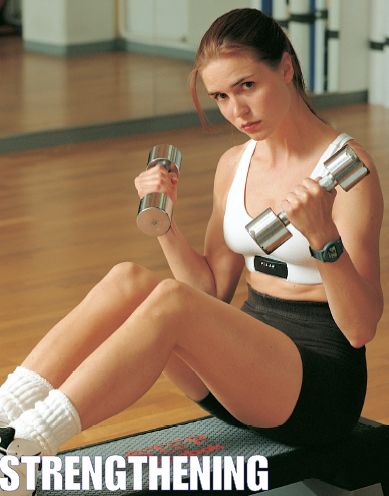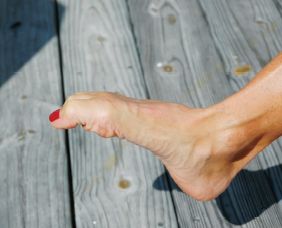

There are a few strengthening activities that can help your running. But I must tell you that overall, I don’t believe that running is a strength activity. As noted in the “running form” chapter, running is done most effectively, in my opinion, when you use your momentum. I call running an “inertia activity.” In other words, you get your body into motion with a few steps, then just maintain that momentum. Therefore, the strength you need for running is minimal. With these facts on the table, it won’t surprise you that this chapter is quite short.
There are a few strengthening activities that can help your running. But I must tell you that overall, I don’t believe that running is a strength activity. As noted in the “running form” chapter, running is done most effectively, in my opinion, when you use your momentum. I call running an “inertia activity.” In other words, you get your body into motion with a few steps, then just maintain that momentum. Therefore, the strength you need for running is minimal. With these facts on the table, it won’t surprise you that this chapter is quite short.
Just look at the physiques of the faster runners. There is hardly any muscle development, and no bulk. Carrying around extra superstructure that doesn’t help you move forward is extra work for the body—causing a slowdown later in a long run. In strength contests with other athletes that I have attended, runners tend to score at the bottom. When I competed at the world-class level, I didn’t know a single competitor who spent an hour doing weight work, on a regular basis—unless their high school or college track coach made them do it.
| Note: |
these exercises are not meant to be
prescriptions for medical problems. They are offered from one
runner to another because thousands have reported benefit from
them. If you have a back or other medical issue, make sure your
doctor and other specialists give you permission to use these
exercises.
|
Toe Squincher—for prevention of injuries of the foot and lower leg
I believe that this exercise will help just about every person that runs and walks. Whether barefooted or not, point your toes and contract the muscles of your foot until they cramp. It only takes a few seconds for this to happen. You can repeat this exercise 10-30 times a day, every day.

This is the best way I know to prevent a foot injury called plantar fascia—but it strengthens the areas all over the foot and ankle for better support. I’ve also heard from runners who believe it has helped to prevent Achilles tendon problems.
Postural muscle exercises
By balancing the strength of muscles on the upper body, that support your posture, you’ll tend to maintain positive upright posture while running, walking, or in other of life’s activities. In the upright position that is natural for you, running is easier. You’ll move forward more efficiently with less energy required for keeping your body balanced.
Good postural muscles will also allow for more efficient breathing. You’ll be able to breathe deeply, which will reduce side pain, and enable you to maximize oxygen absorption.
There are two groups of muscles that need to be strengthened. On the front side, the abdominal group provides support and balance. When ab strength is balanced by back and neck muscles, you will resist fatigue in the shoulders, neck, and back.
Front muscles: the crunch
Lie on your back on a cushioned carpet or floor pad with adequate cushioning for your back. Bend your knees. Now raise your head and upper back very slightly off the floor. Go up an inch or two and down, but don’t let the upper back hit the floor. As you move very slightly, don’t let the stomach muscles relax; keep them working as you go up and down in this very narrow range of motion. It also helps, as you are doing this, to roll slightly to either side, continuously moving. This strengthens the whole range of muscle groups that support the front side of your torso.
For the back, shoulders and neck: arm running
Holding a dumbell in each hand while standing (not while running) go through a range of motion that you would use when running. Keep the weights close to your body as the hands swing from your waist up to your shoulders, and return.
Pick a weight that makes you feel, after a set of 10 repetitions, that you got a workout out of the muscles involved.
But, don’t have so much weight that you have to struggle as you get your last 1-2 reps. Start with one set of 10, and increase to 3-5 sets, once or twice a week. This can be done on a running day, or on a rest day.
Prescriptive exercises
These are designed for those who feel that they need more support in one or more of the areas listed below. Those who have had regular aches, pains or injuries in one of the areas below have received benefit from these exercises.
Knees—the stiff leg lift
If you have weak knees, here is an exercise that strengthens the various muscles in the thigh. By developing strength in the range of muscles above, you may tighten the connections around the knee getting better support.
When this group, the quadraceps, have more strength, and you keep your foot in a small range of motion directly below the hips, the knee has less stress.
Sit on a tall bench or table. With a stiff leg, lift the leg up and down, gradually changing the range of motion from inside to outside. Start with no weight, and one set of 10 lifts. When you can easily do 3 sets of 10 lifts with each leg, add a few pounds using a bag or pocketbook, looped around the ankle.
Shins—2 exercises
The foot lift
Sit on a bench with the knee bent at a right angle. Your foot must be significantly off the floor. Hang a bag or pocket book with a pound of weight over the foot. Lift your foot up and down 10 times. Move the angle of the foot to the inside and the outside. Add more weight as a set of 10 feels easy.
Heel walking
Use a very padded shoe. Walk on your heels, so that your toe region is off the floor. Start with 10 steps, and increase until you can do 2-3 sets of 20-30 steps.